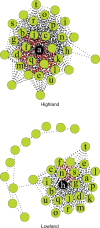Conservation of Sex-Linked Markers among Conspecific Populations of a Viviparous Skink, Niveoscincus ocellatus, Exhibiting Genetic and Temperature-Dependent Sex Determination
- PMID: 29659810
- PMCID: PMC5905450
- DOI: 10.1093/gbe/evy042
Conservation of Sex-Linked Markers among Conspecific Populations of a Viviparous Skink, Niveoscincus ocellatus, Exhibiting Genetic and Temperature-Dependent Sex Determination
Abstract
Sex determination systems are exceptionally diverse and have undergone multiple and independent evolutionary transitions among species, particularly reptiles. However, the mechanisms underlying these transitions have not been established. Here, we tested for differences in sex-linked markers in the only known reptile that is polymorphic for sex determination system, the spotted snow skink, Niveoscincus ocellatus, to quantify the genomic differences that have accompanied this transition. In a highland population, sex is determined genetically, whereas in a lowland population, offspring sex ratio is influenced by temperature. We found a similar number of sex-linked loci in each population, including shared loci, with genotypes consistent with male heterogamety (XY). However, population-specific linkage disequilibrium suggests greater differentiation of sex chromosomes in the highland population. Our results suggest that transitions between sex determination systems can be facilitated by subtle genetic differences.
Figures


Similar articles
-
Viviparous Reptile Regarded to Have Temperature-Dependent Sex Determination Has Old XY Chromosomes.Genome Biol Evol. 2020 Jun 1;12(6):924-930. doi: 10.1093/gbe/evaa104. Genome Biol Evol. 2020. PMID: 32433751 Free PMC article.
-
Embryonic gonadal and sexual organ development in a small viviparous skink, Niveoscincus ocellatus.J Exp Zool A Comp Exp Biol. 2006 Jan 1;305(1):74-82. doi: 10.1002/jez.a.249. J Exp Zool A Comp Exp Biol. 2006. PMID: 16358273
-
Sex chromosome evolution in lizards: independent origins and rapid transitions.Cytogenet Genome Res. 2009;127(2-4):249-60. doi: 10.1159/000300507. Epub 2010 Mar 23. Cytogenet Genome Res. 2009. PMID: 20332599 Review.
-
Sex reversal explains some, but not all, climate-mediated sex ratio variation within a viviparous reptile.Proc Biol Sci. 2022 Jun 8;289(1976):20220689. doi: 10.1098/rspb.2022.0689. Epub 2022 Jun 1. Proc Biol Sci. 2022. PMID: 35642367 Free PMC article.
-
Sex Reversal in Reptiles: Reproductive Oddity or Powerful Driver of Evolutionary Change?Sex Dev. 2016;10(5-6):279-287. doi: 10.1159/000450972. Epub 2016 Oct 29. Sex Dev. 2016. PMID: 27794577 Review.
Cited by
-
Pleistocene divergence in the absence of gene flow among populations of a viviparous reptile with intraspecific variation in sex determination.Ecol Evol. 2021 Mar 25;11(10):5575-5583. doi: 10.1002/ece3.7458. eCollection 2021 May. Ecol Evol. 2021. PMID: 34026030 Free PMC article.
-
With or Without W? Molecular and Cytogenetic Markers are Not Sufficient for Identification of Environmentally-Induced Sex Reversal in the Bearded Dragon.Sex Dev. 2021;15(4):272-281. doi: 10.1159/000514195. Epub 2021 Mar 23. Sex Dev. 2021. PMID: 33756476 Free PMC article.
-
Using a Handful of Transcriptomes to Detect Sex-Linked Markers and Develop Molecular Sexing Assays in a Species with Homomorphic Sex Chromosomes.Genome Biol Evol. 2024 Apr 2;16(4):evae060. doi: 10.1093/gbe/evae060. Genome Biol Evol. 2024. PMID: 38526014 Free PMC article.
-
Highly rapid and diverse sex chromosome evolution in the Odorrana frog species complex.Dev Growth Differ. 2022 Aug;64(6):279-289. doi: 10.1111/dgd.12800. Epub 2022 Aug 25. Dev Growth Differ. 2022. PMID: 35881001 Free PMC article.
-
Using Sex-Linked Markers via Genotyping-by-Sequencing to Identify XX/XY Sex Chromosomes in the Spiny Frog (Quasipaa boulengeri).Genes (Basel). 2022 Mar 24;13(4):575. doi: 10.3390/genes13040575. Genes (Basel). 2022. PMID: 35456381 Free PMC article.
References
-
- Adkins-Regan E, Hudson KR.. 2014. Sexual dimorphism in body size and the origin of sex-determination systems. Am Nat. 183(4):519–536. - PubMed
-
- Alho JS, Matsuba C, Merila J.. 2010. Sex reversal and primary sex ratios in the common frog (Rana temporaria). Mol Ecol. 19(9):1763–1773. - PubMed
-
- Benjamini Y, Yekutieli D.. 2001. The control of the false discovery rate in multiple testing under dependency. Ann Statist. 29:1165–1188.
Publication types
MeSH terms
LinkOut - more resources
Full Text Sources
Other Literature Sources

